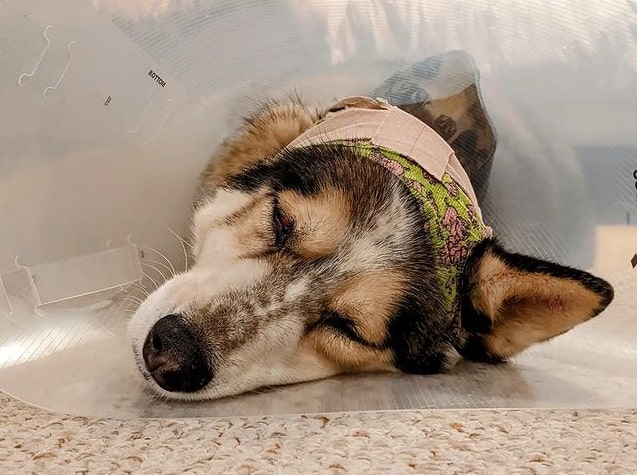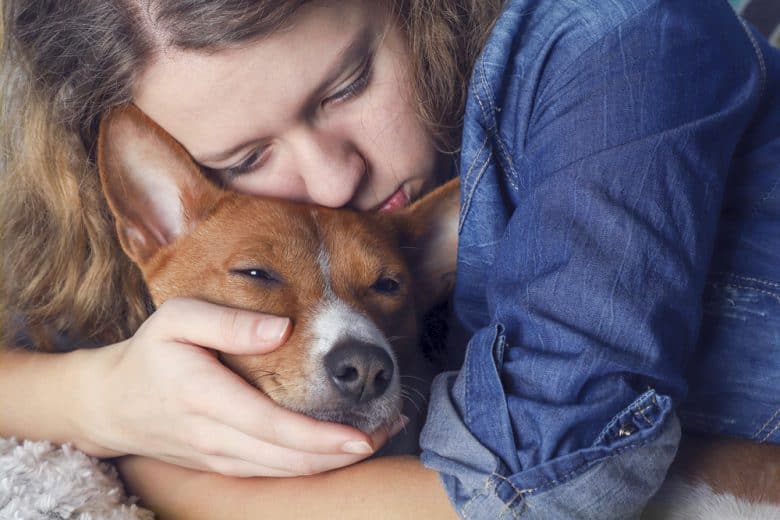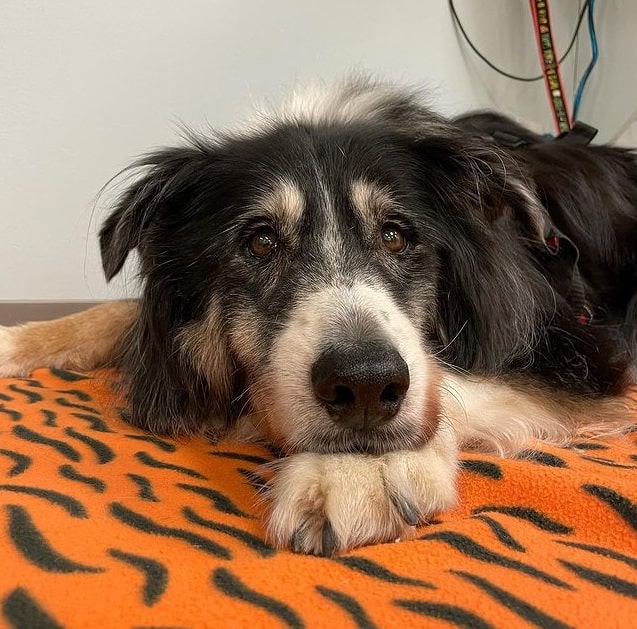Last Updated on April 25, 2023
We all want our pets to live forever, but unfortunately, there comes a time when every pet needs to cross over to the doggie kingdom in the sky.
It can be heartbreaking to watch the light go out in your dog’s eyes as you remember them for the happy, energetic puppy they once were. But what are the signs that indicate your dog may be about to die?

Quick Navigation
- 1 Is Your Dog Dying or Just Sick?
- 2 Early Signs a Dog is Dying
- 3 Imminent Signs a Dog is Dying
- 4 What to Expect After Your Dog Dies
- 5 Why is Your Dog Acting Fine If They are Dying?
- 6 How to Comfort a Dying Dog
- 7 You Think Your Dog is Dying: What’s Next?
- 8 Frequently Asked Questions:
- 9 Understanding When It is Your Dog’s Time to Die
- 10 Further reading: Understanding Canine Illnesses
Is Your Dog Dying or Just Sick?
If you’re worried that it might be near the end for your beloved pooch, you don’t want them to suffer. But how do you tell the difference between a mild illness and something more serious?
Each dog is unique and will behave differently, but you know your pet best, so be sure to trust your instinct in this time. Which can be difficult, considering the emotional roller coaster you are going through.
You might see a gradual behavior change, in which your dog has good days and bad days, or the symptoms may come on quickly and strongly.
There are numerous things to look for that could indicate your dog is close to dying. For instance, if your super-hungry pup just refuses to eat, or your once energetic bundle simply can’t get off the couch, you might need to prepare for the worse.
Be sure to schedule an appointment with your vet to get your furry friend checked out.
Early Signs a Dog is Dying

Various indicators show your dog is not feeling himself. While these could be signs of dying, they might also indicate that your dog is in pain, uncomfortable, or feeling particularly sick.
If your dog seems to be having more bad days than good ones, you need to consider their quality of life in their final days.
Here are some early signs to look out for:
1. Dog is lethargic
While certain dog breeds are just lazy, a very lethargic dog that just lies around a day without moving could be a sick dog. If your pet usually is full of beans and suddenly loses all energy, be sure to take them to the emergency clinic right away.
If your dog simply isn’t able to move at all and you can’t pick him up to put him in the car, try and find a vet that will do a home visit to check on your pet.
2. Change in appetite
Most dogs love to eat, with mealtime being the favorite part of many a dog’s day. When your dog suddenly refuses to eat, it’s one of the first signs that he may be sick or dying.
You can try offering your dog chicken and rice and see if he will eat that. If your dog has experienced a loss of appetite and doesn’t eat anything for three days or more their body will start to shut down.
3. Weight loss
Dogs that refuse to eat or don’t have any energy may lose muscle mass and weight. The closer your dog is to dying, the more their appetite will decrease, causing them to lose weight.
This lack of appetite and weight loss is often accompanied by your dog’s digestive organs shutting down.
4. Loss of interest
Your pet might start to lose interest in their favorite things, such as treats and toys. Your dog might not want to play.
In some cases, your dog stops responding to you altogether. This happens as your pet’s brain functions begin to decrease, causing them to become detached.
5. Social detachment
Dogs can become quite antisocial in their final days. They may stop coming to greet you, cease to wag their tail when you enter the door or even hide away from contact. A noticeable change in your dog’s behavior can be cause for concern.
While it may seem like your dog isn’t interested in you anymore, this doesn’t mean he wishes to die alone.
Many pet owners make the mistake of not being in the room when their pet passes away, and this can be devastating for your dog as you have been the center of their world their entire life.
6. Other signs and symptoms
Some other signs and symptoms that your dog is dying could include getting confused and wandering off, an inability to get comfortable, temporarily losing consciousness, or going into a dazed state.
Imminent Signs a Dog is Dying

If your dog has been chronically ill for quite some time with liver failure, heart or kidney disease, or is quite old, he may be on his way out.
Along with the above signs that your dog is dying, here are some more telltale signs that could warn you that your pet is about to pass away.
1. The dog has reduced mobility
Many large breed dogs, such as Great Danes, struggle to walk as they reach their senior years. These large breeds are at an increased risk for developing arthritis and joint problems, and it can be difficult for owners to care for a giant dog that simply cannot move on its own.
Watch out for bed sores on immobile dogs which can become infected.
Smaller dogs may also lose mobility, become uncoordinated, and weak as their body starts to shut down.
2. Loss of muscle control
Loss of coordination or muscle twitching is often a symptom of poisoning, pancreatitis, or kidney disease.
Severe muscle tremors could also be a sign that your dog has consumed large amounts of chocolate, moldy compost, or xylitol.
3. Decreased thirst
Some dogs refuse to drink in their final days. The water in their stomach can cause them to feel nauseous. A dog that stops drinking water for two to three days is in danger of kidney failure.
You can try offering your dog a water bowl or bottle where he is lying or even putting a little Gatorade in your dog’s water to enhance the taste and smell. Just make sure it doesn’t contain xylitol, an artificial sweetener that is particularly dangerous for dogs.
You can also try feeding your dog canned food that has a much higher water content than regular kibble and thus helps with hydration.
4. Loss of bladder or bowel control
In the final stages of life, some dogs forget their potty training and have accidents in the house. Incontinence issues are especially true for dogs with kidney disease.
These canines will be producing too much urine for their body to hold it all in. Older dogs with arthritis may also struggle to get up to relieve themselves.
5. Dog is restless
Some dogs in their final stages of life become very restless and anxious. These dogs may be unable to sit still and pace back and forth regularly. This can be due to pain or changes in the brain.
Dogs can develop a disease similar to Alzheimer’s known as Canine Cognitive Dysfunction.
6. The dog is in pain
Your dog may start to avoid touch if he is in pain. You might also notice that your pup is more vocal, whining, crying, yelping, and growling.
If your dog is touched in a way that causes pain, he may also retreat or even develop aggressive behavior such as biting. A dog that excessively grooms himself, shakes or trembles, could also be in pain.
7. The dog has labored breathing
If your dog sticks his neck out, gasps for air, or is unsettled when he lies down; he may have difficulty breathing. You may also notice a change in your dog’s regular breathing pattern, causing them to breathe deeper, louder, or heavier than usual.
Everyday activities, like walking to their food or water bowl, may leave your pet out of breath.
This is particularly common with elder dogs, so be sure to keep their accessories close and easy for them to reach. Also, try and keep your dog calm and avoid activities that could cause them to expend too much energy.
8. Changes in gum color
Most dogs have gums that are bubblegum pink in color. On the other hand, dogs that are very sick or dying often have blue or white gums.
While a dry mouth usually indicates sickness and dehydration, discolored gums are generally a sign of system failure.
9. Cool body
A dog about to die sometimes loses their ability to retain its body temperature and may be cool to the touch. You can provide your dog with a pet jersey or a blanket to keep him warm and snug.
What to Expect After Your Dog Dies

If you’ve never had to put down a dog, you may be wondering what to expect in the final moments as your dog crosses over. Let’s take a closer look at some of those things.
1. Post-death reflexes
During the euthanasia process, your dog may shake a bit or experience tremors from residual nervous system activity. While distressing as a dog owner, this is an entirely normal process and does not mean your pet is still alive.
Some dogs also keep their eyes open in death, regardless of whether they pass away naturally or through euthanasia.
2. Bladder/bowel emptying
When your pet passes away naturally or through euthanasia, he may leak urine or stool. This can happen whether or not your dog has recently eaten and is due to the muscles relaxing.
3. Lack of heartbeat and breathing
If you decide to opt for euthanasia to end your pet’s suffering, the injection will cause your pet’s breathing to cease and his heart to stop. This is a quiet and peaceful process and not one that will cause your dog any pain.
Your dog may take one final deep breath before his heart rate slows.
If they pass away naturally, their heart rate and breathing may also speed up before it suddenly slows and ceases altogether.
Why is Your Dog Acting Fine If They are Dying?

Every pet is different, so the signs and symptoms of your dog’s near-death can vary from dog to dog. In the final days, some dogs may know that death is imminent and become overly attached to their owners, seeking out an extra cuddle wherever possible.
While chronic illness can cause months of sickness in some dogs, others only show the signs of dying a few days or even hours before they pass. Some dogs remain active and eat right up until the end.
Also, if your dog dies from something sudden like a heart attack or brain clot, he may never show any of these signs.
Also, some pet owners have reported a final surge in energy just before the end. Their dogs suddenly start eating or playing again, making them think everything is well before passing away.
Often the behavioral traits seen before make a return and are more pronounced before your dog eventually succumbs.
How to Comfort a Dying Dog

You’ll want your dog to feel calm and comfortable in their last days. There are a few ways that you can do that, including the following:
1. Stay close to your dog
While you may be uncomfortable facing the fact that your dog is dying, don’t dissociate from your pet. Be sure to shower him with love and affection while making your dog as comfortable as possible in its last moments.
Put their dog bed in your favorite spot in the house and keep a calming energy in your home.
Dogs are very sensitive to humans, so try not to show too much sadness, which can distress your pet. Instead, be soothing and calm and just try and show your pet how much you love him.
2. Keep your dog clean and dry
Keep your pet’s bed clean and dry. If your dog can’t move outside to go to the bathroom, try and carry him out regularly. If that isn’t possible, you can put potty pads underneath your dog and change them regularly.
A warm cloth under your dog’s tail will prevent matting and urine scald. You might also want to trim away the fur around their tail and bum to avoid any mess and make it easier to clean.
3. Don’t introduce your dog to new people or places
Try to keep your beloved dog in a comfortable environment in his final days. While you might think it is a good idea to go on one last adventure with your furry friend, this can be distressing to your dog, particularly if he is suffering from mental confusion.
Try to reduce stimulation and avoid introducing new people to your pet, as this could be disorientating for your dog.
Also, try and limit interaction with rowdy children and adults, and keep your movements around your pet gentle, especially if he is struggling with pain. You may need to explain to your kids why they can’t play with their dog in the same way.
4. Maintain normal activities as long as your dog is able
As your dog gets older, try and take them for walks and engage in playtime for as long as they are interested and able to do so. While these activities may slow down or become shorter as your pet ages, he will still appreciate the routine.
Just be sure to never push your dog beyond what he can do.
Also, try and maintain your dog’s regular feeding times. You may need to keep your dog’s food and water bowls nearby, so they don’t have to exert excess energy finding them.
5. Give your dog some medication
Some certain supplements and medications can help calm a dying dog. Melatonin, S-Adenosylmethionine (SAMe), and Selegiline can help keep your dog relaxed.
There are also prescription foods that help dogs with cognitive diseases and pain management. If your dog isn’t eating, your vet might also be able to prescribe an appetite stimulate.
If your dog is suffering from a terminal illness, there are also a variety of medications that may be able to prolong your pup’s life.
You Think Your Dog is Dying: What’s Next?

If you think your dog is dying, you will need to consult your vet regarding the next steps. You will want to talk to your friends and family that know and love your dog about whether to go for euthanasia or try and let your dog pass away naturally.
Try and keep an open mind in this regard as you may need to change your decision at the last minute.
If you have scheduled a euthanasia appointment for your dog, you may want to take a day off just to say goodbye. Spend the day spoiling your dog and give them plenty of their favorite foods, be that a nice juicy steak or a delicious ice cream.
Try not to overdo it as you don’t want your pet to be in more pain from an upset stomach.
You may also want to invite your friends and family to say goodbye to your dog for the final time. These loved ones can also act as support for you in this difficult time.
You might also want to take to your vet about doing a house call to perform the euthanasia at home where you and your dog feel the most comfortable.
During euthanasia, your dog will be given a sedative that helps them relax and puts them into a sleepy, drowsy state. Once your pet is relaxed, your vet will administer the euthanasia injection.
You will then need to choose what you want to do with your dog’s body, be that cremation or burial. Your vet also may give you an option to memorialize your pet by planting their ashes in a tree or creating an item of jewelry from them.
It is also a good idea to think about these things before your pet passes so that you can create some mementos before they go. For instance, you could get their paw cast as a display item or do a photo shoot with your dog for the last time.
Frequently Asked Questions:

How long does it take for a dog to die of old age?
While euthanasia is a common option for pet owners, there is nothing wrong with letting your dog die naturally of old age. If your old dog is not struggling to breathe, refusing to eat, or in severe pain, then they can pass away naturally on their own.
Your vet will advise you on how to keep your dog comfortable as he gets older. Some vets even offer end-of-life care and hospice care for elderly dogs.
Like Labrador Retrievers and Spaniels, most medium-sized dogs live to around ten to twelve years old, while smaller dogs, like Dachshunds and Yorkshire Terriers, can live to fifteen or seventeen years old.
What are things to consider regarding decomposition after your dog passes away?
If your dog has experienced a natural death at home or you wish to have him buried, you may be wondering how long it takes for a dog to decompose.
The speed of decomposition will depend on the weather, if the dog is placed in the ground, the PH of the soil, and if the body is wrapped.
A fresh body cools and enters the rigor mortis phase around three to six hours after death. If your dog is in contact with the ground at this stage, flies will begin to lay their eggs in the body.
After that, gas will start to accumulate in the body, giving it a bloated look. This is the phase where a dog’s body may begin to smell. This can happen 10 to 12 hours after death.
After this, worms will start feeding on the body, and the active decomposition phase begins. As a result, it is advisable not to wait longer than 24 hours after death before burying your dog.
When burying your dog, you want to ensure that you dig a hole at least two to three feet down to allow for proper decomposition. Complete decomposition can take anything from six months to 18 years.
If you prefer to bury your pet, you may decide to do it at a pet cemetery rather than in your garden to prevent your kids one day from unburying him.
Once your dog has passed away, you may also consider having your pet cremated. Immediately after death, you will be able to spend as much time as you want with your pet if you decide on euthanasia.
Your vet will typically then make arrangements for the crematorium to pick up your dog if that is your decision, and you will be able to decide what to do with the ashes.
The ashes typically take one to two weeks to be returned to you if you wish to keep them.
What are the stages of grief?
Often the grieving process for your pet starts before they even pass away. Denial can be one of the first steps in this process as you fight to do everything to keep your pet alive.
While you don’t just want to put your pet down at the first steps of illness, it’s important to acknowledge when your interventions are doing more harm than good.
The grueling process of deciding if you should let your dog die naturally on their own or euthanize them to put them out of their agony can be very emotional. It’s important not to dismiss your feelings during this time.
The grief experienced from pet loss can be pretty debilitating but you need to give yourself time to grieve and may even need to seek out resources for managing your grief. Your vet’s office may offer grief counseling to help you get through this difficult time.
Understanding When It is Your Dog’s Time to Die

As you can see, there is no set way on how the final hours of your dog’s life will go. There are many signs and symptoms that your dog is nearing the very end.
Your beloved pet may display a few of these for months before he passes or may only show changes in behavior right at the end of their life. In some cases, dogs appear fine just before they die.
While difficult, it is a good idea to think about how you will manage the end part of your dog’s life so that you are well informed before needing to make any snap decisions.
This will help you to be better equipped when it comes to memorializing your pet for the future.
These are not easy decisions to make, and saying goodbye to your best friend can be one of the most challenging moments in your life.
So be sure to give yourself time to grieve and seek out help from friends, family members, and even professionals if you need it.
Further reading: Understanding Canine Illnesses
Cess is the Head of Content Writing at K9 Web and a passionate dog care expert with over 5 years of experience in the Pet Industry. With a background in animal science, dog training, and behavior consulting, her hands-on experience and extensive knowledge make her a trusted source for dog owners.
When not writing or leading the K9 Web content team, Cess can be found volunteering at local shelters and participating in dog-related events.
